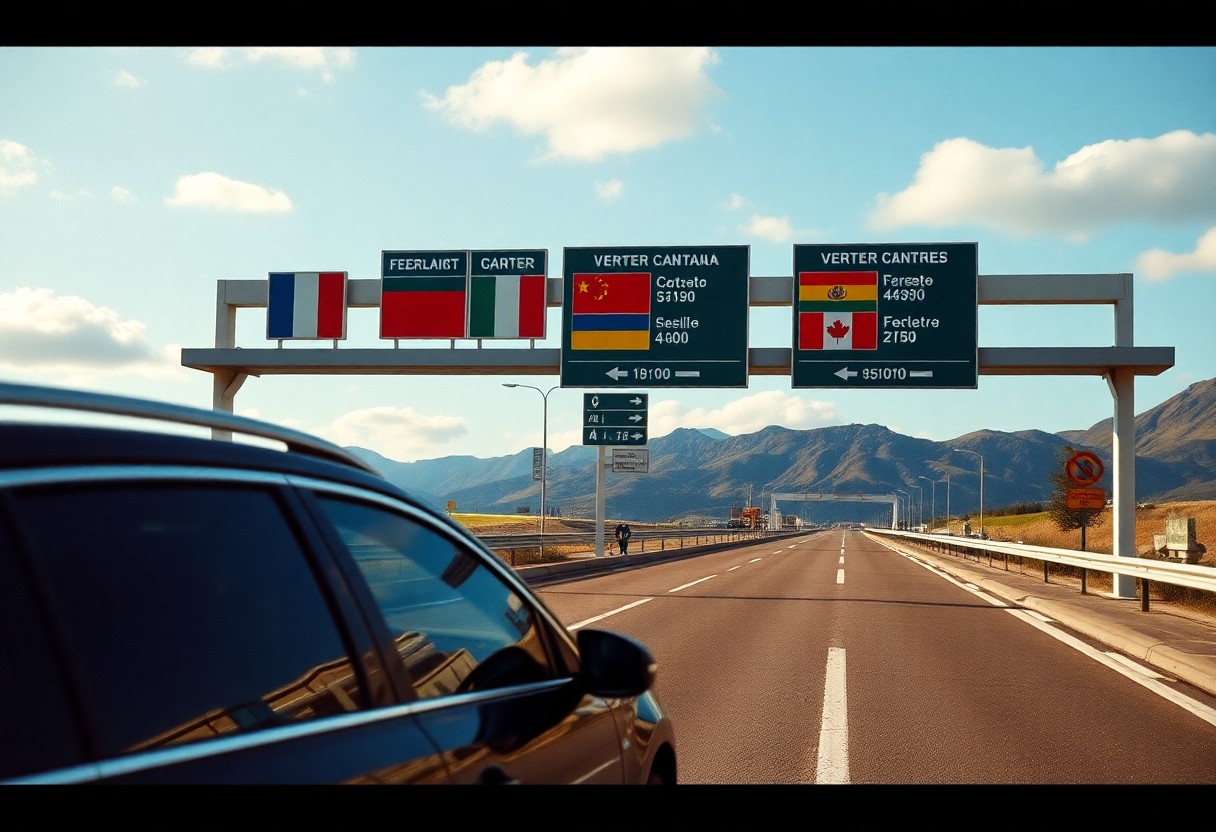When preparing for overseas travel in Europe with a rental car, engaging in strategic planning is essential to ensure a smooth and memorable adventure. This preparation involves not only carefully mapping out your travel route but also gaining a comprehensive understanding of cross-border regulations that can significantly impact your trip. Rental companies frequently have varying policies regarding travel between European nations. Typically, most providers permit travel within Western European countries, yet restrictions are often placed on Eastern European destinations. It is crucial to thoroughly scrutinize your rental agreement, which will specify the borders you are allowed to cross and any potential fees involved. Before you finalize your reservation, it is imperative to confirm that your chosen rental agency permits travel to all your intended locations, as breaching cross-border regulations could void your insurance and result in substantial penalties. Hence, acquiring detailed insights into these policies is vital for a successful European road trip.
Understand Legal Requirements for Cross-Border Travel in Europe
Before embarking on your European adventure with a rental car, it is crucial to fulfill key legal and rental company requirements to ensure a hassle-free experience. Verify that your rental agreement explicitly grants permission for cross-border travel, and importantly, confirm that you possess valid insurance coverage for every country included in your travel itinerary. Many rental agencies impose restrictions based on specific European zones, especially for luxury vehicles. Therefore, it is essential to educate yourself about these requirements to avoid any issues that could detract from your travel experience. Being well-informed about the legalities involved can prevent potential fines or complications while you explore the stunning landscapes of Europe.
Obtain Your International Driving Permit (IDP) Before Departure
One of the most vital documents required for driving in Europe is the International Driving Permit (IDP). It is mandatory to acquire this permit in your home country before initiating your travel plans. The IDP serves as an essential supplement to your standard driver’s license and is legally required in numerous European destinations. By obtaining your IDP well before your trip, you ensure compliance with local driving laws, significantly enhancing your experience across diverse nations, allowing you to focus on appreciating the breathtaking vistas and rich cultural experiences.
Understand Mileage Policies and General Restrictions
Renting a car in Europe often comes with the enticing benefit of unlimited mileage, a significant advantage for adventurous travelers eager to explore the continent. However, it's essential to be aware that border crossing fees apply, which can vary significantly, typically ranging from €5 to €47.60 per crossing. These fees depend on your rental company and the specific countries included in your travel plans. Furthermore, due to insurance regulations and security measures, rental agencies frequently enforce specific restrictions for various vehicle categories. For example, premium brands like BMW, Mercedes, and Audi usually have more limited travel zones compared to standard models. Therefore, it’s imperative to communicate your travel intentions clearly to avoid unexpected charges or complications.

Gain Insights into the Cross-Border Policies of Major Rental Companies
When renting a car in Europe, comprehending the distinct cross-border policies of different rental companies is crucial for a successful journey. Leading rental providers generally permit travel between Western European nations; however, strict restrictions often apply to travel in Eastern Europe. These policies can differ significantly based on the type of vehicle you choose, with luxury cars frequently facing more limitations compared to standard models. By familiarizing yourself with these policies beforehand, you can make informed decisions regarding your rental options and effectively plan your travel itinerary.
Investigate the Cross-Border Regulations from Avis and Enterprise
Avis and Enterprise are notable rental companies that provide extensive coverage across Western Europe. Their vehicles are typically allowed for travel in most EU nations, including popular destinations like France, Germany, and Spain. However, it's important to note that both companies impose specific restrictions on luxury vehicles, particularly when entering Italy. For instance, Enterprise charges a daily cross-border fee of 5 euros, with a maximum total charge of 50 euros. Understanding these fees will assist you in budgeting effectively for your travels across the diverse landscapes of Europe.
Analyze the Cross-Border Policies of AutoEurope and Hertz
Among the leading rental providers, AutoEurope and Hertz enforce specific country restrictions that are critical for travelers to comprehend. For instance, taking their vehicles into Eastern European nations such as Albania, Belarus, or Ukraine is prohibited. Additionally, Hertz restricts luxury vehicles and SUVs from entering Italy, while AutoEurope’s policies may vary depending on their local partners. Therefore, it is crucial to communicate your travel plans to your chosen provider before reserving your rental car. Your rental agreement will clarify the applicable cross-border fees, which can vary by company and destination. For example, Hertz charges 47.60 euros for crossing from Germany to another approved country, and you may require additional insurance coverage for international travel.
Be Mindful of Geographical Restrictions When Traveling
The regulations regarding cross-border travel with rental cars in Europe can vary widely based on your rental company and the type of vehicle you select. Your rental agreement will clearly outline which countries you are authorized to visit with your rental car. It is essential to keep your rental agency informed of your planned route, as crossing borders without proper permission can void your insurance and lead to significant penalties, potentially resulting in a frustrating experience during your travels.
Identify Countries You Are Permitted to Drive In
Most rental companies allow for unrestricted driving within Western European countries, including France, Germany, and Spain. Zone 1 countries typically encompass EU member states in Western Europe, providing the most flexibility for your rental car usage. Your rental agreement will detail all the permitted countries relevant to your vehicle class, ensuring you have a clear understanding of where you can travel, thus enabling you to maximize your European adventure.
Recognize Areas Where Rental Cars Are Prohibited
Countries behind the Iron Curtain often face stringent travel restrictions. Most rental companies restrict travel to Eastern European nations, including Albania, Belarus, Ukraine, and Russia, due to heightened risks and potential insurance complications. Moreover, additional limitations may apply specifically to luxury vehicles and certain car brands. High-end vehicles like BMW, Mercedes, and other premium models frequently face stricter geographical limits. If your travel itinerary includes multiple countries, it is advisable to opt for a standard vehicle class to enhance flexibility and minimize potential fees or insurance issues.
Understand Vehicle-Specific Restrictions for Rental Cars
While rental companies may have differing policies, most uphold strict regulations concerning which vehicles can cross borders. Therefore, it is essential to check the specific limitations associated with your chosen vehicle class prior to making a reservation. These restrictions are enforced to protect valuable assets and ensure compliance with insurance requirements across various European territories, thus safeguarding both the rental agency and the traveler.
Enjoy the Flexibility of Standard Rental Cars
Contrary to common misconceptions, standard rental cars actually provide the greatest flexibility for cross-border travel. Generally, you can drive standard vehicles in most Western European countries without needing special permits. However, it is necessary to inform your rental company about your travel intentions beforehand and be prepared to pay cross-border fees ranging from 5 to 50 euros based on the circumstances and your travel plans.
Understand Limitations on Luxury Vehicles for Border Crossings
Significant restrictions apply to high-end vehicles regarding cross-border travel. Luxury cars face notable limitations on border crossings, with renowned brands such as BMW, Mercedes, and Audi often barred from entering Eastern European countries or Italy. Typically, these premium vehicles are restricted to Zone 1 countries within Western Europe, which can considerably limit your travel options.
Furthermore, if you choose to rent luxury vehicles, anticipate higher security deposits and stricter insurance requirements. Rental agencies like Sixt and Enterprise impose limitations on premium brands such as Jaguar, Maserati, and Porsche, permitting them only in select Western European countries. For any border crossings, special permission will be necessary, along with possibly additional insurance coverage to ensure compliance with rental policies.
Budget for Border Crossing Expenses
When preparing for any cross-border journeys in Europe with a rental car, establishing a clear budget is crucial. Most rental companies charge additional fees for crossing borders, even within the Schengen Area, which can influence your travel budget. It is essential to inform your rental agency about your intended route and acquire written permission before crossing any borders to avoid unexpected financial burdens.
Typical Fees for Border Crossings to Anticipate
Border crossing fees in Europe typically range from €5 to €50, depending on the rental company and specific circumstances. For instance, crossing from Germany to another permitted country may incur a fee of €47.60 with Hertz, while Enterprise charges €5 per day, with a maximum limit of 50 euros for trips originating in Germany. Being aware of these fees in advance will assist you in better financial planning during your travels across Europe.
Consider Potential Additional Charges You May Encounter
At certain borders, you may face extra insurance requirements and documentation fees. Your rental company might impose charges for special permits, especially when traveling to Eastern European countries or when using luxury vehicles. Additionally, it’s wise to consider the potential for higher insurance premiums for specific destinations, particularly in Italy or Eastern Europe. Remember that some credit card insurance policies may not cover all European countries, necessitating the purchase of additional coverage from your rental company to ensure peace of mind during your travels.

Master the Guidelines for Ferry Travel with Your Rental Car
Not all rental companies have the same policies regarding ferry travel within Europe. While most companies allow ferry travel, it is critical to verify the specific rules associated with your rental to avoid complications. Crossing maritime borders often requires additional documentation and may incur extra fees that you should be prepared for. Moreover, your insurance coverage may change when traveling by ferry, making it essential to understand these aspects well in advance of your journey.
Review Company-Specific Policies on Ferry Travel
Among the major rental companies, ferry travel policies can vary significantly. Avis and Hertz typically allow ferry travel to approved countries, but it is crucial to check destination restrictions beforehand to prevent any potential issues. Conversely, Enterprise and Sixt may require pre-authorization and additional insurance for ferry crossings, which must be clearly outlined in your rental agreement to avoid misunderstandings during your trip.
Important Considerations for Breakdown Coverage During Ferry Travel
Another essential factor to keep in mind is vehicle breakdown coverage while traveling by ferry. Most rental companies hold you liable for vehicle repatriation costs if your car breaks down after a ferry journey, which can amount to several thousand euros, depending on your location and the type of vehicle rented. This responsibility extends beyond mechanical failures; if you encounter an accident or if the vehicle becomes unusable for any reason while on an island, you are responsible for the expenses required to return the vehicle to the original rental location. Some rental agencies offer additional insurance to cover these costs, but it is crucial to secure this coverage before your journey to ensure adequate protection.
Essential Tips for Successful Cross-Border Driving with Rental Cars
When planning to drive a rental car across European borders, conducting thorough research and understanding the specific regulations set by your rental company are vital for a seamless experience. While you may enjoy the freedom to cross borders in many European countries, each rental company has its own unique policies and associated fees that you should be aware of. The type of rental vehicle you select can greatly affect your travel flexibility, particularly as luxury cars often face stricter limitations than standard models. Always verify the countries you are permitted to visit, account for any necessary border crossing fees, and review the regulations regarding ferry travel before embarking on your adventure. Diligently reading your rental agreement and obtaining an International Driving Permit will further prepare you for a smooth journey. Your proactive planning is essential to avoid complications at border crossings, enabling you to enjoy a more delightful travel experience.
Your Questions Answered: Driving Rental Cars in Europe
Can I drive my rental car to any European country?
No, rental companies enforce specific regulations regarding the countries you can visit. Most companies allow travel within Western European nations such as France, Germany, and Spain. However, many impose restrictions on travel to Eastern European countries including Albania, Belarus, and Ukraine. Luxury vehicles often come with even more stringent limitations. Always check your rental agreement for the allowed countries before any border crossings to ensure compliance.
Will I incur additional fees for crossing borders with a rental car in Europe?
Yes, many rental companies do impose border crossing fees. For example, Hertz charges 47.60 euros for each border crossing from Germany, while Enterprise charges 5 euros per day (with a maximum cap of 50 euros) for trips originating in Germany. These fees apply even when traveling within the Schengen Area. It is crucial to inform the rental company about your travel itinerary and settle these fees before crossing any borders to avoid unexpected charges.
Can I take my rental car on a ferry between European countries?
Yes, most rental companies allow ferry travel if your destination country is on their approved list. However, if your vehicle breaks down while on an island, you will be responsible for the costs associated with returning the vehicle to its original rental location. Some companies, such as Hertz, offer coverage for ferry travel through their insurance options (CDW, TP, or SuperCover). Always verify the specific ferry policies stated in your rental agreement to avoid any surprises during your travels.
The Article: Is It Allowed to Drive a Rental Car Across European Borders? appeared first on https://rentacar24.org/
The Article Driving a Rental Car Across European Borders: Is It Allowed? Was Found On https://limitsofstrategy.com
The Article Driving a Rental Car Across Borders in Europe: Guidelines First Appeared ON
: https://ad4sc.com



Your insights on the complexities of cross-border travel in Europe with rental cars bring to light an often-overlooked aspect of planning that can genuinely make or break a trip. I have experienced the intricacies of navigating different regulations firsthand during my travels across Europe, and it’s fascinating how each country can have its own set of rules that may impact not just the legality of crossing borders, but also the overall experience of travel.
The nuances of rental car regulations really can feel like navigating a maze, can’t they? It’s surprising how something that seems straightforward can become complicated with different rules for each country. I remember a trip where I thought I was all set, only to find out about an entirely new toll system in the country I was entering. It definitely added some stress to what was supposed to be an enjoyable journey.
It really is like a maze, isn’t it? I often think about how even the most seasoned travelers can get tripped up by unexpected rules and regulations. Your experience with the toll system strikes a chord; I remember renting a car in Italy and being completely caught off guard by the ZTL zones in cities like Florence. It felt like I was learning a whole new language just to drive around.
You’ve touched on such an important point regarding cross-border travel. It often surprises people just how nuanced the regulations can be. When I was traveling between countries in Europe, I found that even seemingly minor rules could lead to significant frustration. For instance, something as simple as differing speed limits or toll requirements can really change the flow of a trip.
You’re right; the nuances of travel regulations can be a real headache. I remember a trip I took that was supposed to be a seamless drive through Europe, only to find myself tangled up in a web of differing rules. It’s funny how something as mundane as speed limits can throw a wrench in the works. I had a similar experience navigating through countries where the speed limits would change unexpectedly, one moment cruising along at a comfortable pace, the next moment being jolted back to reality because I crossed an invisible border into stricter enforcement.
It’s interesting you mention the different regulations in each country. I’ve found that even the smallest nuances, like toll requirements or driving laws, can really set the tone for a trip. For instance, when I drove through France and Italy, I was surprised by how easy it was to navigate the countryside in France, but then I hit a bit of a speed bump in Italy with their ZTL (Zona a Traffico Limitato) zones. I didn’t realize how strict they were until I received a fine in the mail weeks after I returned home.
I can relate to those complexities you mentioned; navigating regulations can be a real puzzle, much like planning the perfect scenic drive in New York, where understanding local car rental nuances enhances the journey.
‘Car Rentals for the Best Scenic Drives in New York’
https://notpotatoes.com/car-rentals-for-the-best-scenic-drives-in-new-york/.
It’s true—those little details can shape the entire travel experience. Your story about encountering the ZTL zones in Italy resonates with many travelers. It’s a good reminder of how local regulations can differ dramatically, and being caught off guard by them can be quite the learning experience.
You’ve highlighted a critical point that often gets glossed over in travel discussions. The regulations across Europe can be bewildering, and I’ve also felt the pinch when trying to navigate different countries with rent-a-car agreements. It really does change how you plan your itinerary, especially if you’re moving through several borders.
I found some great insights on navigating the rental car scene in Miami that might help simplify your travel planning and avoid those unexpected hurdles.
‘Renting a Car in Miami: Essential Tips for Travelers’
https://notpotatoes.com/renting-a-car-in-miami-essential-tips-for-travelers/.
You’ve hit the nail on the head with the complexity of navigating car rental agreements in Europe. Between the different insurance requirements, fuel policies, and varying age restrictions, it can feel like every country has its own playbook. I’ve experienced the same confusion when trying to plan a road trip across borders. You want the freedom of the open road, but all those little details can feel like a minefield.
I appreciate your insights! If you’re looking for more tips on navigating the rental car scene, especially for a smoother experience in Miami, check out this helpful guide: [Renting a Car in Miami: Essential Tips for Travelers](https://notpotatoes.com/renting-a-car-in-miami-essential-tips-for-travelers/). It could make a big difference in your planning!
https://notpotatoes.com/octopus
Navigating the maze of regulations while traveling across Europe with a rental car can feel like unraveling a mystery, can’t it? Your experience speaks to a common challenge many face. It’s a shame how something intended to be enjoyable—a road trip through stunning landscapes—can get bogged down by the fine print of different countries’ regulations.
Navigating the maze of regulations while traveling across Europe with a rental car can feel overwhelming, and you’ve captured that sentiment perfectly. It’s fascinating how the thrill of hitting the open road can quickly transform into a puzzle-solving adventure. Each country has its own rules, little quirks that can easily throw someone off balance, especially if you’re focused more on soaking up the scenery than poring over the fine print.
Absolutely, it can be quite the puzzle! To help simplify your journey, check out this resource that breaks down the essential regulations for driving across Europe. It might just make your road trip a little smoother!
https://notpotatoes.com/quillbot
You’ve hit on such an important point about preparation! I remember planning a road trip through Italy and Spain, and I was blown away by how different the rental policies were between countries. I almost overlooked the insurance aspect—thankfully, I double-checked before signing anything. It’s so easy to assume you can just drive wherever you want, but those border regulations can really catch you off guard.
It sounds like you had quite an adventure planning that road trip! The differences in rental policies can be eye-opening, especially when traveling between countries. It’s interesting how each place has its own set of rules and approaches to things like insurance. It’s easy to get caught up in the excitement of the journey and overlook those nitty-gritty details, but it sounds like you navigated that well by double-checking.
“Absolutely, those nuances can truly make or break a trip! If you’re interested, check out this guide on navigating rental car policies across Europe—it could save you a lot of hassle!”
https://notpotatoes.com/octopus
This is such an insightful look into the intricacies of traveling in Europe with a rental car. Your emphasis on strategic planning resonates deeply with my experiences traveling abroad. I remember planning a road trip through Italy and Greece, and the information about cross-border regulations would have been invaluable during that time. We often underestimate how much preparation goes into what seems like an adventurous journey, especially when navigating different cultures, languages, and regulations.